Here you're going to always find all the latest updates on what's new with AutoTonic. If you need any further support about older releases or want to report bugs etc, please send feedback through email.
2025-02-25 v1.14.2 (Beta Version)
2023-03-16 v1.13 (Beta Version)
2020-11-19 v1.12.3 (Beta Version)
2020-10-22 v1.12
2020-06-23 v1.11
2018-06-10 v1.10 (rev222.1)
2018-04-29 v1.9 (rev220.1)
2018-03-02 v1.8 (rev219.3)
2018-02-07 v1.7 (rev217.3, Beta Release)
2018-01-23 v1.7 (rev216.20)
2017-06-17 v1.6 (rev215.12, Beta Release)
2017-08-01 AutoTonic SE (BEAT Magazine)
2017-06-16 v1.6 (rev215.11)
2017-06-07 v1.6 (rev215.10, Beta Release)
2017-05-31 v1.6 (rev215.9)
2017-02-04 v1.5 (rev213.2, Beta Release)
2017-01-01 AutoTonic CM (musicradar.com)
2016-11-19 v1.5 (rev213)
2016-11-15 AutoTonic Player
2016-10-14 v1.4 (rev212)
2016-10-04 v1.3 (rev202)
2016-07-25 v1.2 (rev198)
2016-07-18 v1.1 (rev188)
2016-07-10 v1.0 (rev176)
2014-08-05 v0.0 (rev0)

Watch the introduction on YouTube:

xoxox ... automatic Capitalization of 1st letter, when not set xooXox ... capital letter defines pattern offset (=index) xooOox ... index can also be non-active (=silent index, capital letter "O") xoo(x)ox ... silent index can be also set by parentheses xoo60ox ... rootDIGIT defines the exact static MIDI#number target xooF#ox ... rootCHAR represents the target tonic, 'floating' across all +/- octaves [xoo60ox] ... square brackets make the enclosed pattern static/locked in place Xoxox xoO ... multiple pattern strings can be used {Xoxox, xoO} ... alternatively several other glyphs can be used for clarity F ... rootCHAR standalone or with trailing "/" and scaleModifier string results in global tonic switching /xoxoxxoxoxox ... scaleModifier strings with a leading "/" result in global scale switching. these strings must match the 12-glyph x/o-Modifier Syntax and can be also copied by clicking on the ScaleModifier label G#/xoxoxxoxoxox ... tonic and scale switching can be also combined and already copied like that by ALT+Click on the scaleModifier label xoxox xooCox [xoo60ox] xoF#ox xoxoo(O)oooox [xoFooooooox] [xo][Fooooooox] C#/xoxoxxoxoxox xo60ox+1 /xoxoxxoxoxox xo60ox+1 xoo[60]ox xoo[xo60ox] F#/xoxooxoxooxo xoo[xo60ox]-1 xoooooO [56] C#/xoxoxxoxoxox xoCox-2[58] C#/xoxoxxoxoxox xoCox[54] C#/xoxoxxoxoxox xoCox-1C/xoxxoxoxooxo xoxoo(O)ooooxooooxooooxooooxoooox(slow)ON enables dynamic help cards when hovering particular key elements 15 MB. While this is a slight drawback, it doesn’t affect the application’s speed since the extra resources are only used when Help Mode is active (the size doesn't cause any difficulties in running). Having an up-to-date, interactive in-app help guide makes this small space increase worthwhile. If you prefer a smaller version, I’m considering creating a lightweight alternative. Please email me if you’re interested, so I can gauge demand.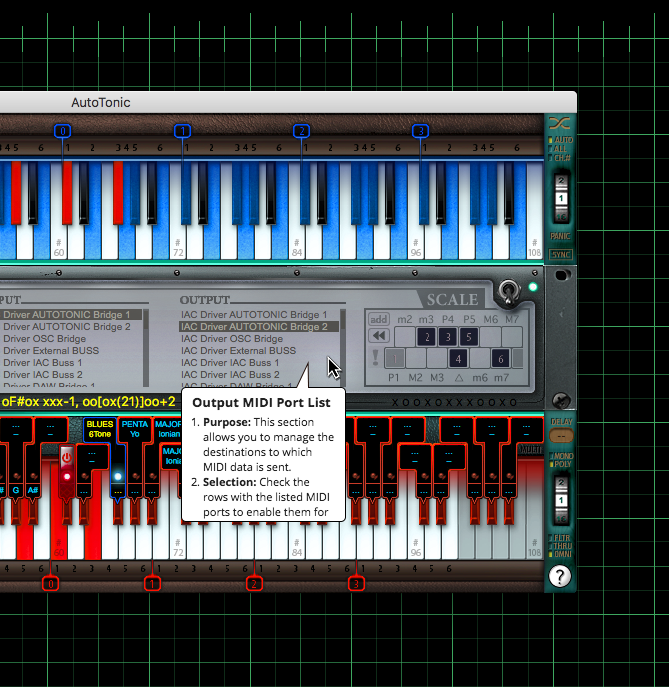
.txt file called AutoTonicSkin.txt .txt file with default parameters is created on launch, in AutoTonic's default user folder, here ...
/Users/YourName/Library/Application Support/AutoTonic/AutoTonicSkin.txt C:\Users\YourName\AppData\Local\AutoTonic\AutoTonic\AutoTonicSkin.txt .txt file's first block represents the currently active UI color scheme ALT+Click on the RESTART label opens the .txt document with the system's default text editor (it's advised to preview color modifications immediately by simply clicking the `RESTART' button to apply the changes and relaich zhe application automatically) .txt file can be simply deleted (eg, by moving it to the trash), a new file with the default parameters will be created on application launch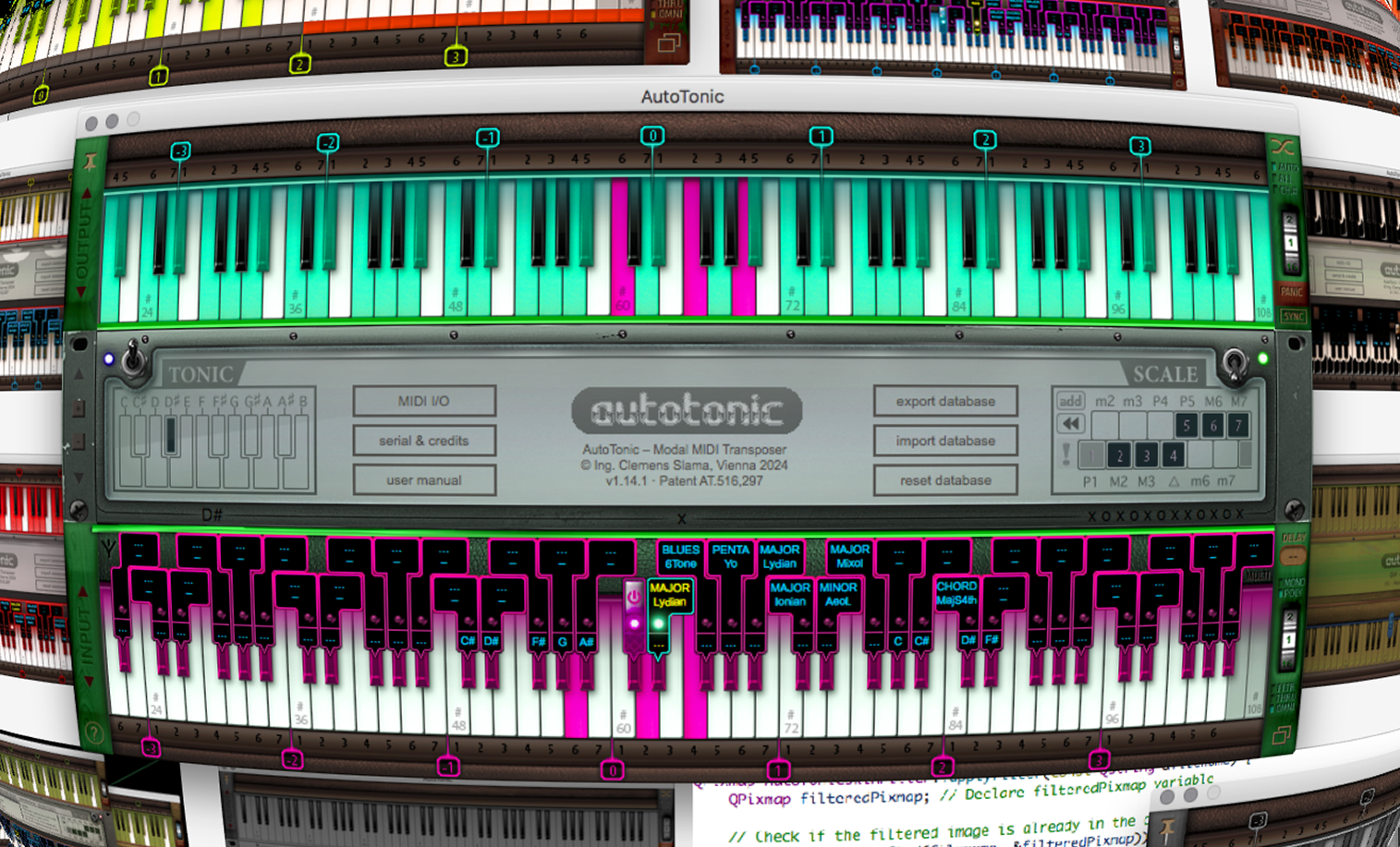
Security & Privacy > General > Allow App/ Open Anyway (…) 
Introducing NUKE Mode, a new feature that unlocks a whole new way to play music with AutoTonic. With an all-white keys input keyboard layout and an innovative alternate keyboard concept, NUKE Mode allows you to play even on black keys. Simply toggle it on by clicking on the lower right screw or by using the shortcut "N".
NUKE Mode also enables you to feed existing pieces of music through AutoTonic and reharmonize them in real-time. I've had a blast experimenting with various titles, from Nothing Else Matters to Beethoven's Mondscheinsonate Nr. 14 or Smells Like Teen Spirit by Nirvana. NUKE Mode even temporarily handles pitch offsets when the source material has momentary ascending or descending runs.
With NUKE Mode, anyone can hit any major, minor, fourth, or other chords they may already be familiar with without losing the context of the initial finger pattern-ratio in perspective to the resulting transpositions. Although I don't have much documentation on it yet, once you switch it on, it converts all black keys into playing keys as well.
However, there are some known bugs with NUKE Mode. It still doesn't work with PIVOT key switchings and/or x/o-patterns, and there are several improvements that could be made in how it chooses where the target note of any incoming black key lands. These issues are case-specific and will require some more time to resolve.
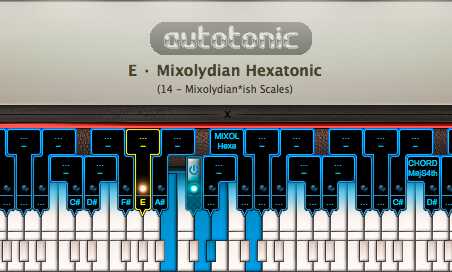
These two new modifier widgets now displays the current settings below the modifier panel and allows you to copy them by clicking on them. In addition, you can now drag and drop SongMarkers to create MIDI files on the fly, which is useful for recalling from DAW. This feature requires AutoTonic to be routed to receive signals from the port that the DAW's channel is sending to.
AutoTonic now also supports getting recalled/programmed from external sources. MIDI notes 0-11 (C-2 to B-2) trigger the tonic change, while MIDI notes 109-119 (C#7 to B7) trigger the scale modifier change. This enables real-time reverse learning of any tonic/scale scenario, which can be recorded directly into a DAW and recalled from there.
The CenterScreen now displays the current Scale-/Tonic-Settings when in CleanMode (which can be toggled to be shown). This is particularly useful for users who found the headers too small before.
Also, there is now a new button that allows the application window to stay on top of all other windows. Simply click on the new PIN needle on the top left to activate it.
This feature will restore the position of the application window to its previous location when the program is closed and reopened.
This experimental feature adds new buttons to resize the entire application window, addressing a common request from users who wanted to see the Headers/UI larger and higher rendered. However, some features, such as MIDI IN/OUT scroll wheels and pin-on-top, are currently disabled. Note that resizing the window multiple times in a row may cause some wobbling and bugs.
This feature allows users to fold and expand the three main sections of AutoTonic: InputKeyboard, CenterScreen, and OutputKeyboard. With the arrow buttons on the left, users can toggle the corresponding panel to shrink or expand the application window, giving them the option to focus on a specific section while working on other tasks.

This mode cuts off notes immediately after any note ON signal. It can be enabled by clicking on the lower left bolt in the center screen. It's a fun and inspirational feature to use!
Security & Privacy > General > Allow App/ Open Anyway (…) 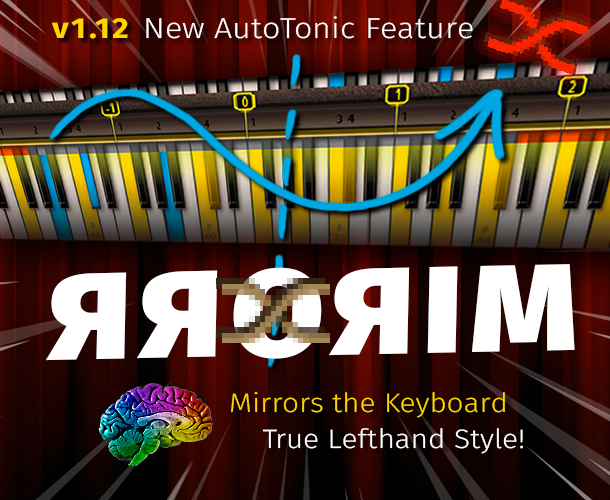
This update will introduce a new MirrorKeys feature that allows to completely flip the playing upside down (so high notes to the left and vice versa with the low ones) \u2026 this feels incredible inspiring to use and I am really thrilled to share this with all of you finally. You can think of it in terms of a lefthand-keyboard, which can be assigned to AutoTonic's true 'modal' mapping.
I am working on the code now all by myself finally and things just take sometimes longer than expected, as everything also got even more complex with every new change. But I've changed the main logic for the signal routing and now you will only see the according channel#1-16 signals when the ScrollWheels are set equally. This not only avoids any potential note hanging with interferring MIDI channels, but also brings wonderful new techniques to life.
AutoTonic v1.12 – NEW #ЯЯOЯIM Keys
Watch the introduction on YouTube:

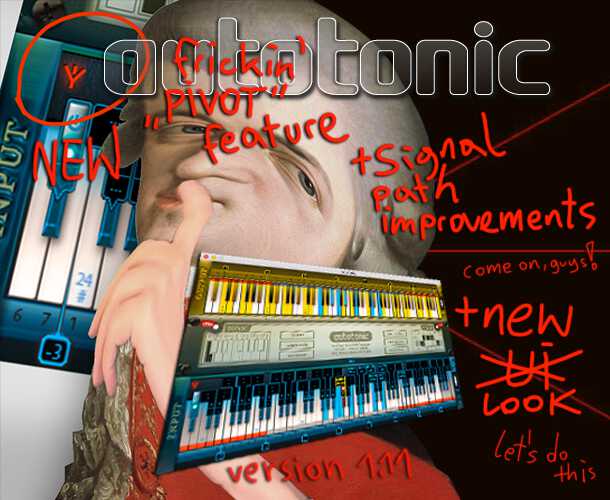
AutoTonic Update v1.11 introduces a new "Pivot Modulation" feature, which allows now to assign "PivotSets" (Hey, think of them as "hot keys") for instant modulation during your input playing -- you can now create harmonic changings of the most complex nature without the need of any additional gestures.
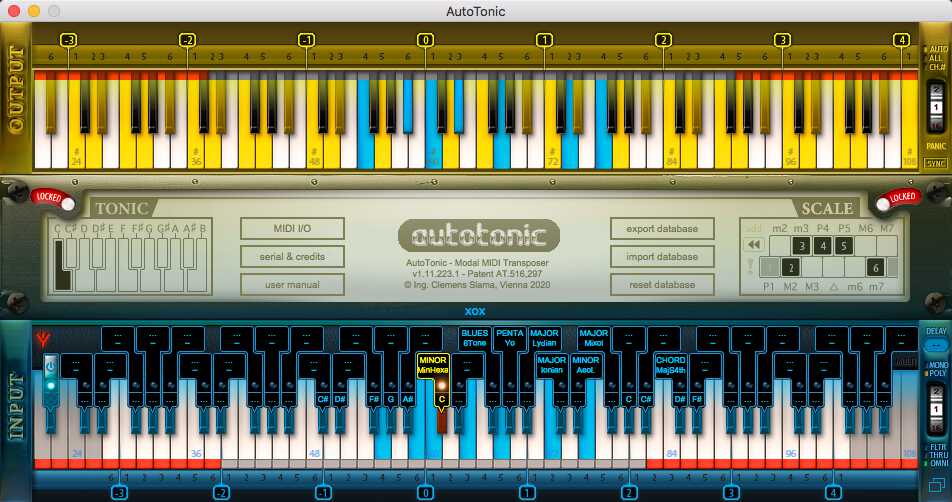
Sounds complex? It really isn't, simply hold down the ALT key to enter "PivotLearn" mode and while keep pressing you can now select by mouse (or midi input) any custom white key or combination of white keys that should become the newly assigned toggle switches for your current selected Header. A red overlay will indicate the assignments. Once you exit this learn mode AutoTonic will automatically trigger that exact black key's Header always when you come across these learned white keys.
You can assign for every existing Header any combination of white keys to set up your custom tonal modulations and additionally it is also highly suggested to make use of the previously added "Delay" feature to compensate for any computing latency upfront to the actual key switching and therefore enable instant chord modulations ... so newly played chords can already appear transposed, instantly on first triggering (very creative to use!).
AutoTonic v1.11 – NEW #PivotKeySwitching, watch the introduction on YouTube:


 - New ‚input channel #‘ methods (->lower scrollwheel=input channel number):
- New ‚input channel #‘ methods (->lower scrollwheel=input channel number):
- Omni = All incoming Midi Channels will be fed into the transposing engine (=now default)
- Filter = Only matching signals will be transposed, other signals are muted/killed
- Thru = Signals on unequal channels will be routed through without change
- Newly opened ‚Instances‘ will use previous input method (Omni/Filter/Thru)
- ‚ALT+Click‘ on ‚New Instance‘-button = new instance with same input/output channel number (default is: ‚input/output channel count +1‘)
- Fix: MIDI Control Data of ‚input channel #‘ follows now ‚output channel #‘ setting (MIDI Clemens Slama, Program Change, Channel Pressure, Pitch Wheel)
- UI Enhancements/Adaptions
- AutoTonic Block Diagram (Signal Path):



- AutoTonic Block Diagram (Signal Path):

AutoTonic has been updated to v1.7.217.3 to provide better compatibility when using Apple's OS X 10.13.3 High Sierra in combination with Logic Pro X 10.4




This public update fixes 2 minor bugs:

Multichannel processing and 422 new scales - AutoTonic updates its Modal MIDI Transposer and adds many useful features: I/O channel selectors, Polyphonic Aftertouch support, newly declared scales, UI improvements, bug fixes etc,
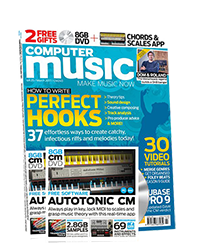


- Free Giveaway Version "AutoTonic Player", made for the KVR Developer Challenge 2016

 - Initial (Public) AutoTonic launch
- Initial (Public) AutoTonic launch




As a result of trying to learn jazzy piano chords and various scales (in the high-times of an EDM era lol,) I ask myself, why the Piano has to look as it is today and start challenging myself if there wouldn't be other design approaches feasible as well … after discussing it with friends over and over again I develop a custom prototype by script-like approaches and using Logic Pro's "Environment" (version 9 back then? which I still use btw.) … throughout looking into the topic of mapping scales linearly out onto the white keys over and over again, I finally discover the idea of using the remaining (left-over) black keys as function toggles/key switches.
If you need any info or further support about older releases or want to report bugs etc, please send feedback through email.